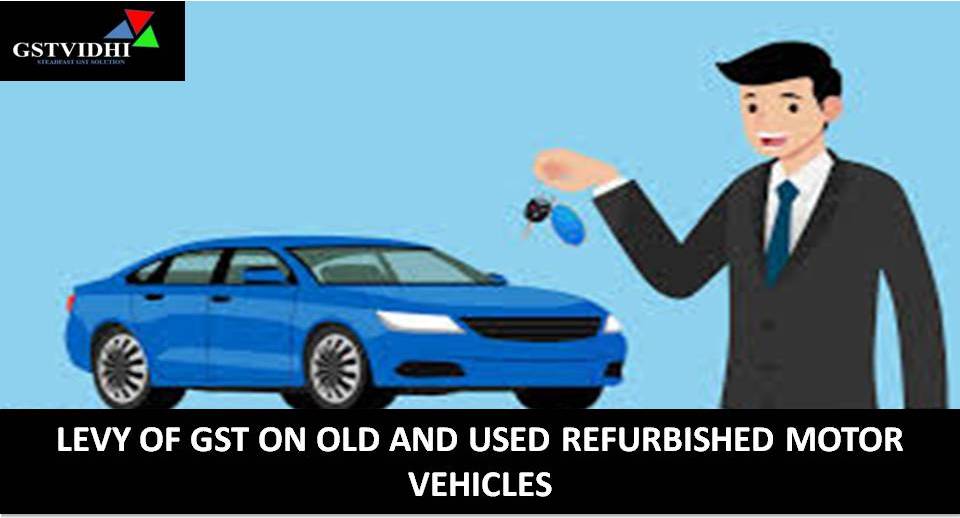
LEVY OF GST ON OLD AND USED REFURBISHED MOTOR
VEHICLES
GST on Used Vehicles: The introduction of Goods and Services
Tax (GST) in India has simplified many tax processes, but the taxation of used
vehicles remains a complex area. This article aims to provide a clear and
concise understanding of GST on used vehicle sales, drawing on Notification No.
8/2018-Central Tax (Rate) and
an important ruling by the Gujarat Authority for Advance Ruling (GAAR)
regarding M/s. Dishman Carbogen Amcis Limited.
Notification No.
8/2018-Central Tax (Rate) Simplifying
GST on Used Vehicles: On 25th January 2018, the Indian government issued Notification No.
8/2018-Central Tax (Rate) to
address the confusion surrounding GST on used vehicle sales. This notification
is critical for businesses involved in buying and selling second-hand vehicles,
as it sets out the applicable GST rates and valuation methods for different
types of vehicles.
Here’s a breakdown of the key provisions:
|
Vehicle Type
|
GST Rate
|
Criteria for Applicability
|
|
Petrol, LPG, CNG Vehicles
|
9%
|
Engine capacity of 1200cc or more length of
4000mm or more
|
|
Diesel Vehicles
|
9%
|
Engine capacity of 1500cc or more length of
4000mm or more
|
|
SUVs (Sports Utility Vehicles
|
9%
|
Engine capacity exceeding 1500cc, length
exceeding 4000mm, and ground clearance of 170mm or more
|
|
All Other Vehicles
|
6%
|
Any used vehicle not falling under the above
categories
|
|
Valuation for GST Purposes
|
Margin Scheme
|
For businesses that have claimed
depreciation: GST is applied on the margin, i.e., the difference between the
selling price and the depreciated value. For others: Margin is the difference
between the selling price and the purchase price
|
|
Input Tax Credit (ITC)
|
Not Allowed
|
No exemption applies if ITC has been claimed
on the vehicle under GST, CENVAT, or any other previous tax regimes
|
GAAR Ruling on M/s. Dishman Carbogen Amcis
Limited: Practical Application
To see how these rules play out in real life,
consider the case of M/s. Dishman Carbogen Amcis Limited, which sought clarity
on how to apply GST when selling a used SUV.
Background: The company purchased an SUV in February 2018
for ₹80 lakhs and did not claim GST Input Tax Credit (ITC) as it was restricted
under the GST Act. At the time of sale, the vehicle’s written down value (WDV)
was ₹47 lakhs, and it was sold for ₹55 lakhs.
Key Questions Raised:
1. How should the GST be calculated?
The company asked if GST should be applied on
the entire sale price or just the margin between the selling price and the
depreciated value.
2. What GST rate applies?
They also sought to confirm the correct GST
rate for the sale.
GAAR’s Decision:
· Valuation: The ruling clarified that GST should be applied only on
the margin (₹55 lakhs ₹47 lakhs = ₹8 lakhs). This margin represents the
difference between the selling price and the depreciated value of the car at
the time of sale.
· GST Rate: The GST rate applicable was confirmed as 18% (9% CGST + 9%
SGST), in line with the notification’s rate for SUVs.
· GST Calculation: The GST was to be calculated on the
margin (₹8 lakhs), which is exclusive of GST. This means the tax is added on
top of this margin.
What This Means for Your Business
1. Accurate Valuation:Ensure you correctly calculate the margin on
which GST will be applied. This is crucial for businesses that have claimed
depreciation on the vehicle.
2. Correct GST Rate: Make sure you apply the correct GST rate
based on the type of vehicle you are selling. Misclassification can lead to
errors and potential penalties.
3. Consider ITC:
Remember that if you’ve claimed ITC on
the vehicle, the margin scheme does not apply, and you will need to pay GST on
the full selling price.
4. Advance Rulings:
If you’re unsure about how to apply GST to a
specific transaction, consider seeking an advance ruling like Dishman Carbogen
Amcis Limited did. This can provide clarity and protect you from future
disputes with tax authorities.
Conclusion: Simplifying GST on Used Vehicle
Sales: Navigating GST on used
vehicle sales can be complex, but with a clear understanding of Notification No.
8/2018-Central Tax (Rate) and
real-world applications like the GAAR ruling, businesses can ensure compliance
while optimizing their tax liabilities. By focusing on accurate classification,
valuation, and understanding the implications of ITC, businesses can turn these
challenges into opportunities for better tax management. This
approach will help you confidently navigate the GST landscape, ensuring you
make the most of the provisions available while staying on the right side of
the law.
Disclaimer: All the Information is based on the notification, circular and order issued by the Govt. authority and judgement delivered by the court or the authority information is strictly for educational purposes and on the basis of our best understanding of laws & not binding on anyone.
Click here